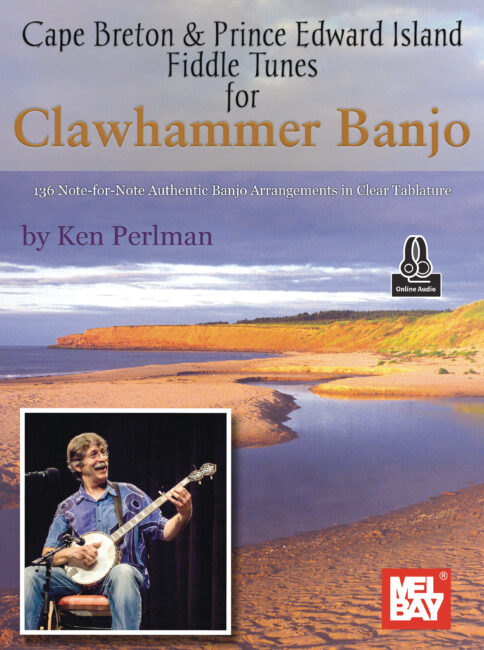Cape Breton & Prince Edward Island Fiddle Tunes for Clawhammer Banjo
Ken’s Brand New Banjo Instruction Book!!
136 Note for Note Authentic Banjo Arrangements in Clear Tablature
Now in Print!!
**Also Available in an Electronic Edition**
http://modernsmile.com/2010/05/ 
Available both in Print and in an E-Book Version
Here’s announcing the publication of my latest instruction book, Thành Phố Lạng Sơn Cape Breton & Prince Edward Island Tunes for Clawhammer Banjo (Mel Bay publications). It features 136 note-for-note skillfully-crafted clawhammer arrangements.
- PRINT EDITION. The print edition is now here! Here’s how to order a copy from me: the price is $29.99.
- ELECTRONIC EDITION. Obtain the E-Book now from the publisher for $24.99.
About Cape Breton & Prince Edward Island Fiddle Tunes for Clawhammer Banjo
The island of Cape Breton & its close neighbor, Prince Edward Island in eastern Canada are home to two of the oldest, strongest, and most vibrant fiddling traditions in North America. Cape Breton gave rise to a professional Celtic-based fiddling scene to rival anything coming out of Scotland & Ireland. Prince Edward Island’s traditional fiddlers developed lively, idiosyncratic styles every bit as musically compelling as anything you’ll hear on archival recordings of iconic American old-time fiddlers from the Appalachians. This book features 136 tunes from these two distinct but related fiddling traditions, collected by the author directly from master fiddlers, and arranged note-for-note for clawhammer banjo with as much flavor and nuance as possible. These settings of reels, hornpipes, jigs, marches, strathspeys, airs, and other fiddle tunes are all eminently playable and fully benefit from the author’s half-century of experience playing banjo, arranging for banjo, writing banjo instruction books, and researching fiddle-music traditions.
Here’s what you’ll find in this volume.
- 136 fiddle tunes arranged for clawhammer banjo in clear tablature
- Over 40 musical examples & exercises
- Instruction on basic and advanced techniques
- Fingering diagrams & detailed fingering suggestions
- A systematic approach to playing up-the-neck
- A thorough treatment of playing triplets, grace notes, & other ornaments in clawhammer
- Guides on how to approach playing various kinds of fiddle tunes
- A framework for understanding the modes encountered in fiddle music
- Historical notes on the tunes and musical traditions
- Biographical information on source fiddlers
- Includes online access to 169 audio illustrations**
** Note: Most audio illustrations for the tunes in this book are drawn directly from the author’s own CDs, Devil in the Kitchen, Frails & Frolics, Island Boy, and Northern Banjo.**
View Table of Contents (with Complete Roster of Tunes)
Ken Talks About the Book (from the Introduction)
Cape Breton & Prince Edward Island Fiddle Tunes for Clawhammer Banjo presents a collection of 136 fiddle tunes from Cape Breton and Prince Edward Island (P.E.I.), arranged note-for-note for clawhammer banjo with as much flavor and nuance as humanly possible. These “settings” are all eminently playable and fully benefit from my half-century of experience playing banjo, arranging for banjo, and researching fiddle music traditions.
With a very few exceptions, I learned the tunes in this volume directly from master fiddlers steeped in local musical traditions. I learned my first Cape Breton tunes in the late 1980s from John Campbell, Joe Cormier, and Ludger LeFort – three well-known Cape Breton fiddlers who made their homes in the Boston area; and added to that stock by hearing Buddy MacMaster, Jerry Holland and other Cape Bretoners play for dances and concerts at the Canadian-American club in nearby Watertown.
Then in the summers of 1991 and ‘92 – with much assistance in terms of funding and volunteer labor from the Earthwatch Organization of Massachusetts – I conducted a major music-collecting project on P.E.I. and recorded close to one hundred high quality fiddlers from dozens of communities across the Island. Most of these players were taped in their own kitchens with their families and favorite accompanists in attendance. I came away from this experience with the feeling that these artists were every bit as unique and musically intriguing as any folk-instrumentalist I had ever heard on an old 78. Even more important, these fiddlers impressed upon me what their tunes were really for – to make people exhausted from a day of hard physical labor want to get up and dance!
Once I had the recordings in hand I set to work and transcribed many of the tunes into standard notation. Each selection was transcribed as a particular fiddler played it with as much precision as I could muster, including such subtleties of style as ornamentation, double stops, and the melodic idiosyncrasies known in local parlance as twists. The result: living, breathing versions of tunes filled with the vitality of a people whose great love for their music was expressed in every bow-stroke. This first set of transcriptions was published by Mel Bay as The Fiddle Music of Prince Edward Island: Celtic and Acadian Tunes in Living Tradition (1994).
I was certainly no neutral bystander during these recording sessions. As the fiddlers played, I was absorbing elements of rhythm and style. And after nearly every session, most fiddlers would almost demand that I get out my banjo and accompany them. P.E.I. had no banjo-playing tradition to speak of, so this process often led fiddlers to exclaim, “The banjo and the fiddle, they go together pretty good, eh!” I also had many opportunities during the course of the project to attend dances and view how closely many elements of melody and phrasing were linked to movements of the dance.
After I completed any given transcription, my first impulse was to get out the banjo and try to capture the tune’s melody, rhythm, and spirit on my instrument. Ultimately, I worked out literally hundreds of banjo settings. In the years since, I’ve recorded many of my favorites on the four CDs whose repertoires form the heart of this volume – Devil in the Kitchen (1993), Island Boy (1996), Northern Banjo (2002), and Frails & Frolics (2017).